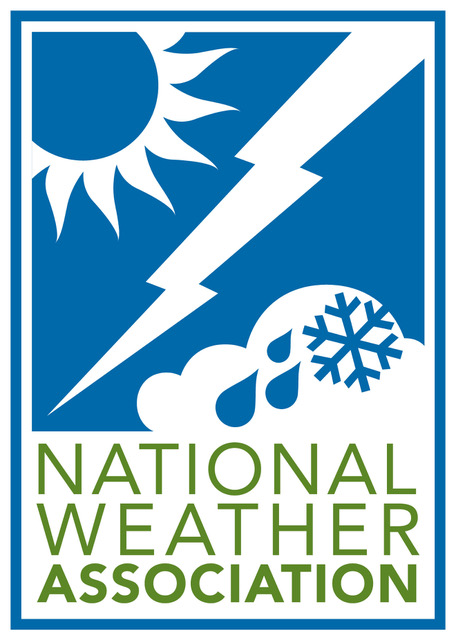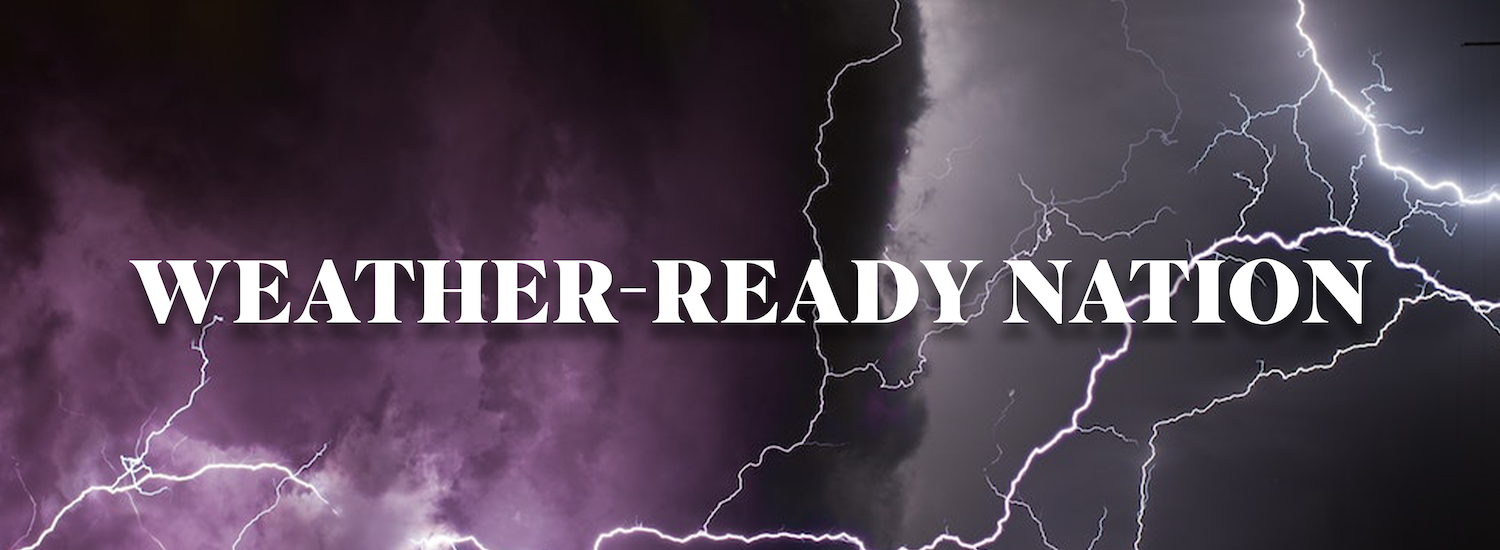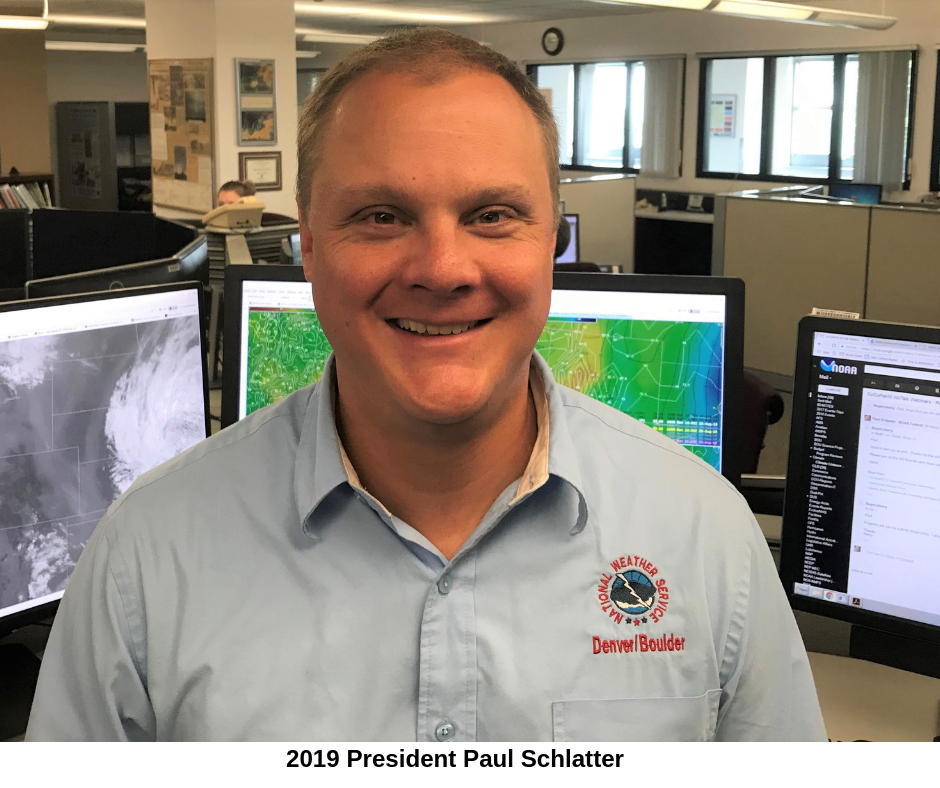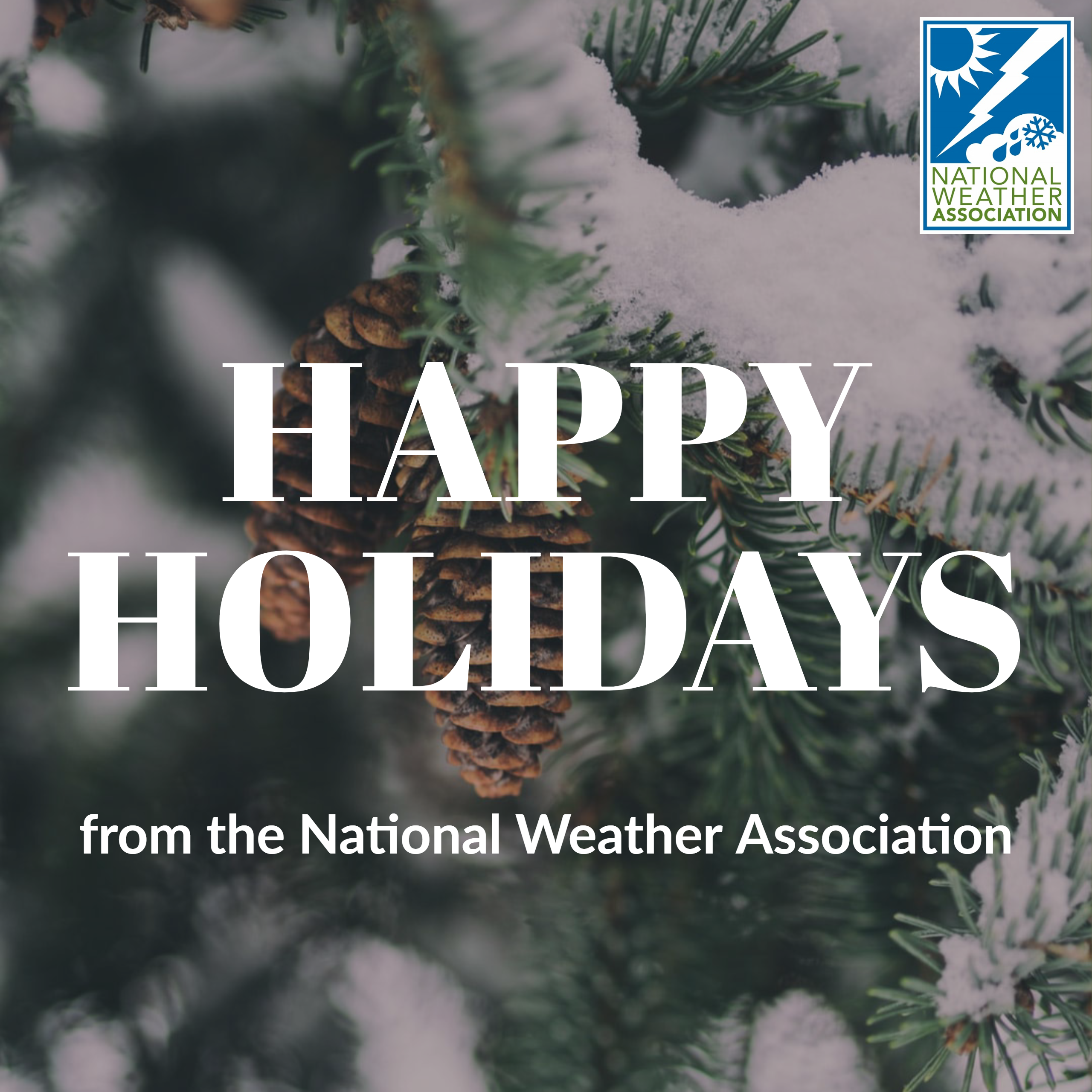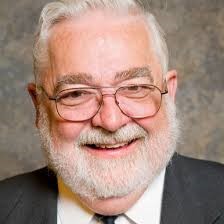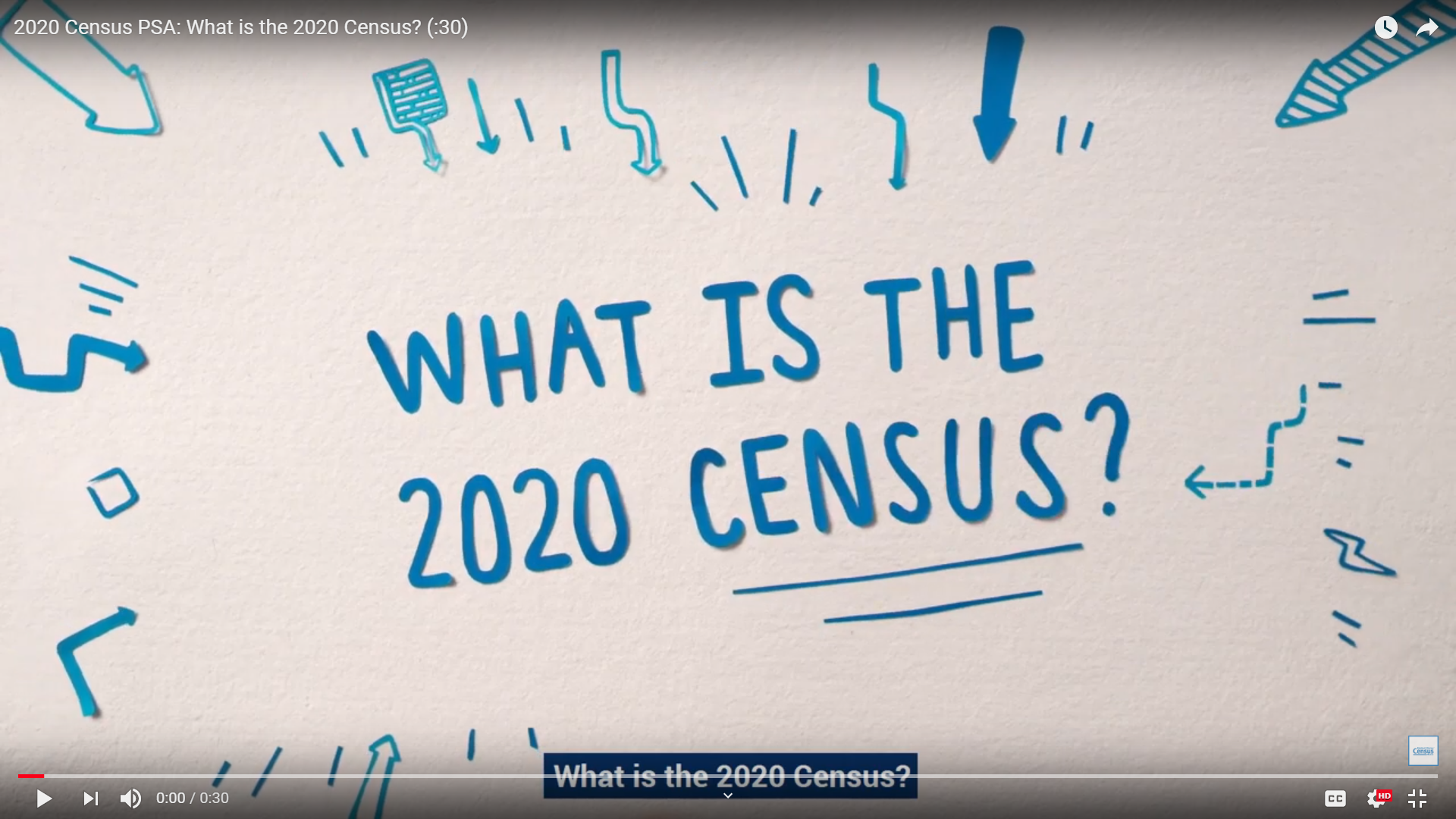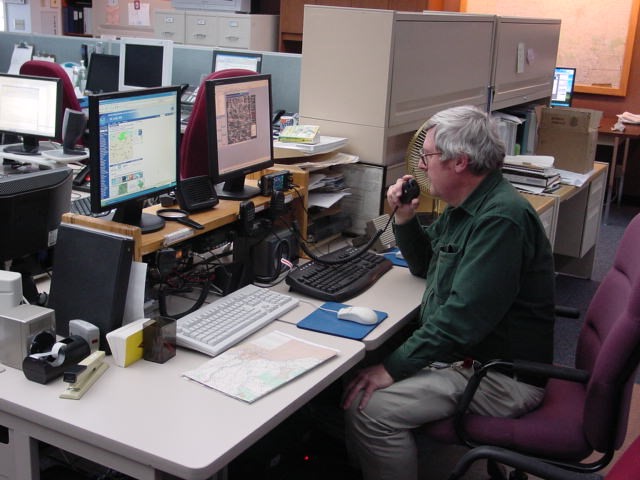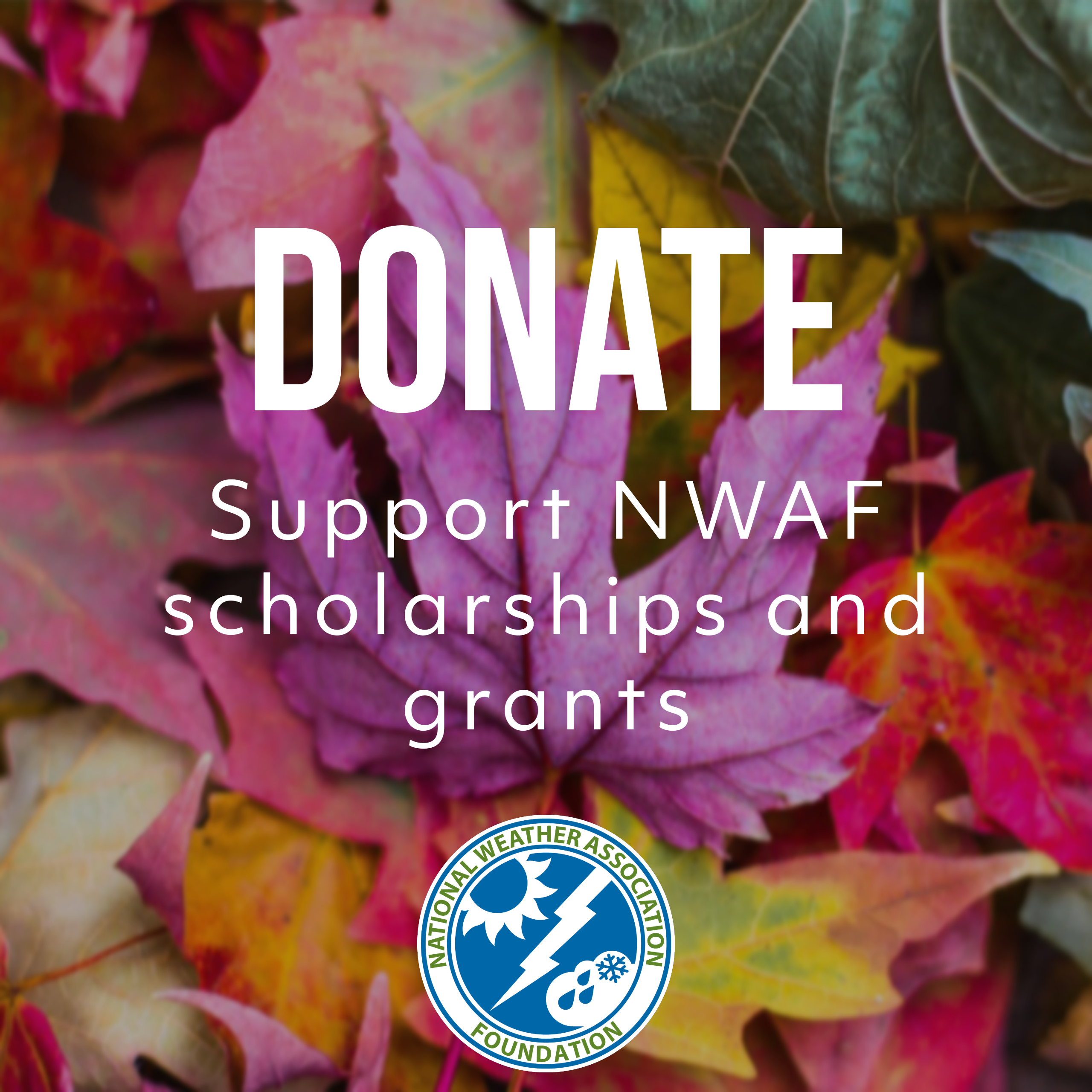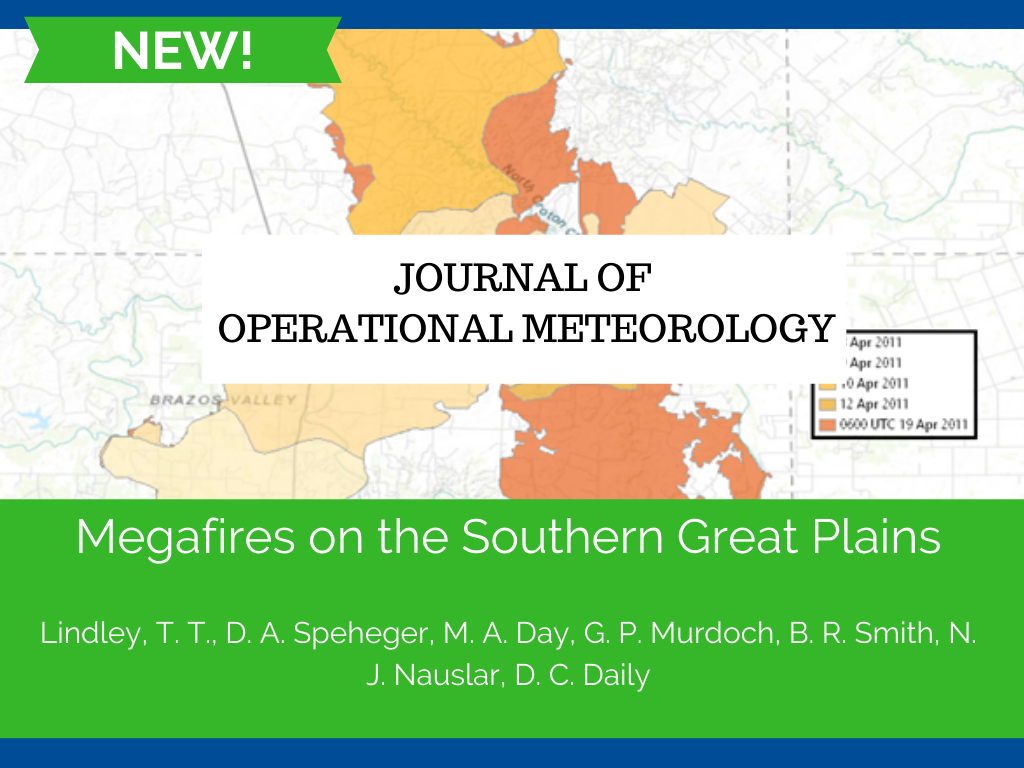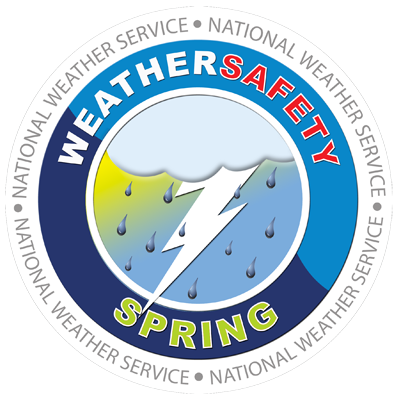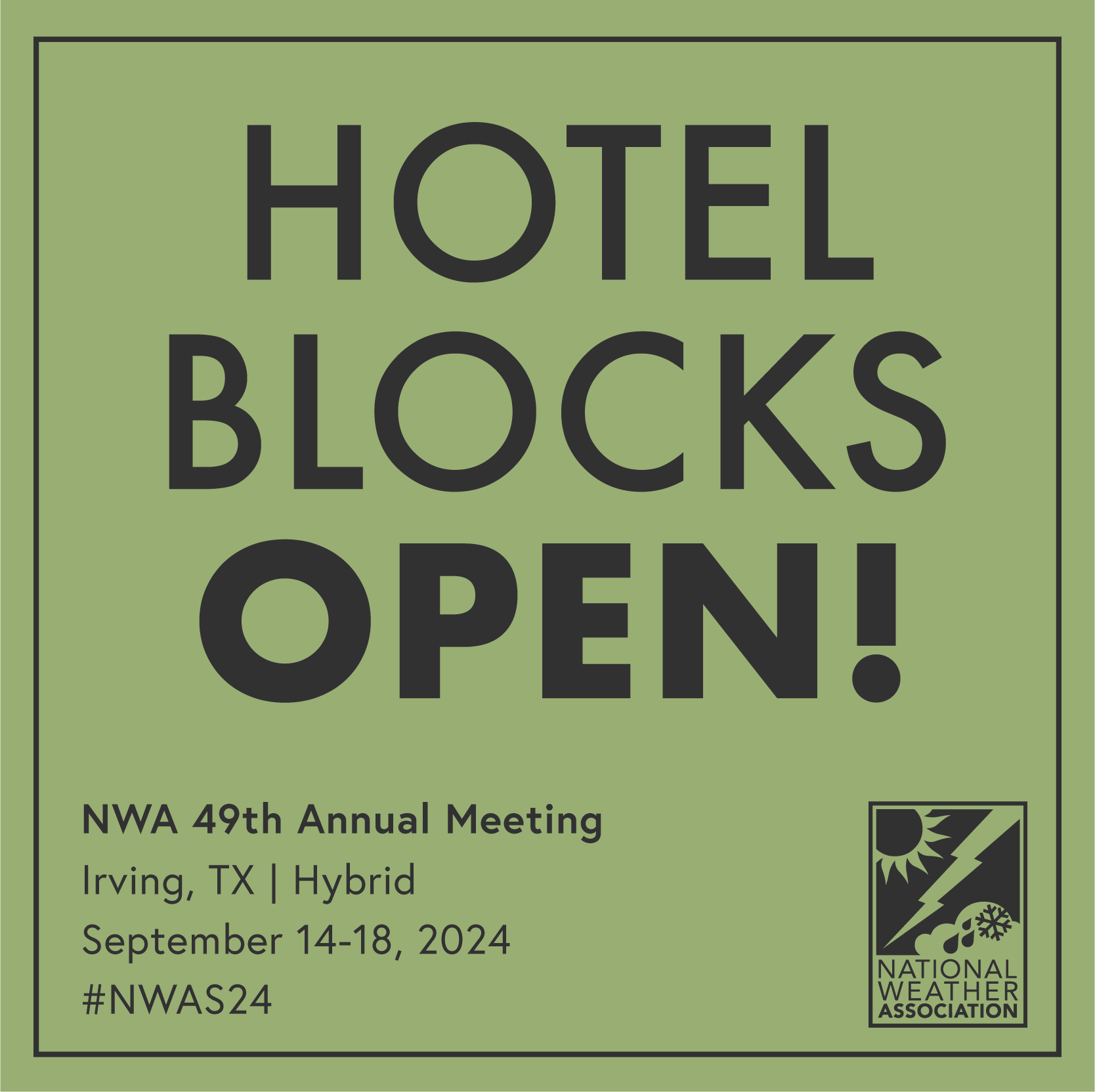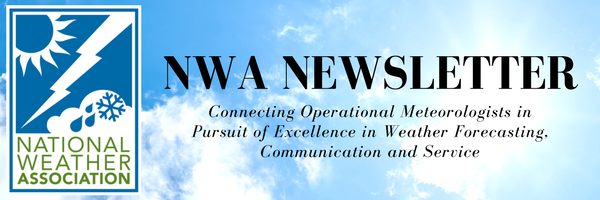 NWA December 2019 Newsletter
Issue 19 - 12
NWA President Paul Schlatter
Happy Holidays National Weather Association! This is my last president’s message, and come January 1, Todd Lericos will go from being president-elect to the 44th president of the NWA. I will miss being president, but I am also excited to serve the association in more of a consultant role as immediate past president. I can’t believe my year as president has already come and gone, and what a great year it has been for the NWA. This was the first full year operating under the revised bylaws, and they are making a major positive impact on how we operate. The Board of Directors work very well together, and with the support of the bylaws, we make efficient decisions to move the NWA forward and better serve our members and the weather community. One of the most exciting changes coming is a restructuring of the NWA committees. A long-standing issue we’ve had with some of our committees are defined roles. Many committees have well defined roles or provide a direct service to the NWA. Those committees are not changing. Some committees, however, were organized around a specific topic or common interest that does not provide a direct service to the NWA. These committees represent a group of people interested in furthering the understanding, and perhaps outreach, of a topic important to operational meteorology. Those committees will soon be organized into “member groups” and will be open to the entire membership to join. The details are in the final stages of being worked out, and in a few months we’ll announce what it will look like and how you can get involved. Be on the lookout next year. A highlight for me over the past year was definitely the annual meeting in Huntsville, Alabama. I’ll admit I say that every year, but I don’t think I am alone in saying the 2019 annual meeting was truly one of the best. We came together to support our community when operational meteorology became politicized. I was SO proud of how we behaved despite the interesting backdrop. The numbers are in, and it turns out the Huntsville meeting was also a significant financial boon to the NWA. As I mentioned in the August President’s Message, the NWA must balance the cost of a venue, the expected number of attendees, and the costs incurred by the attendees, some of whom pay their own travel and registration expenses. Huntsville was an ideal location because of the generous local support from Title Sponsor Baron, the Huntsville/Madison County Convention and Visitors Bureau, the Von Braun Center and all our sponsors, the number of potential attendees within the region, and the reasonably priced hotel rates. Because of the high attendance and other factors, the meeting was a big financial success. Revenues from the meeting help fund NWA expenses throughout the year, which allow us to keep member rates as low as possible. I expect the annual meeting in Tulsa, Oklahoma, will likewise be a big win financially, so make plans to attend September 12-17, 2020, and tell your friends and colleagues to do the same. Finally, I want you to know how much I appreciate this organization and all of you who make it so great. I am honored and humbled to have served as president, and amazed at the heart, character, and abilities of the members of this association. I look forward to continuing to serve alongside you all in the coming years.
Membership Dues Announcement The Renewal period for 2020 dues will open by Dec. 15, 2019. Details are still being added to provide more options for Early Career professionals and to update the 2020 dues prices. Once that is complete, the renewal period will open. Once open, current members will receive an email and see a Renew Button on their My Profile page. We are introducing the Early Career professionals rates in 2020. Here's a breakdown of the rates: Early Career 1 Membership Dues: $37.50. Early Career 2 Membership Dues: $45.00. Early Career 3 Membership Dues: $52.50. Early Career 4 Membership Dues: $60.00. Early Career 5 Membership Dues: $67.50. To apply for these rates, upload a copy of your final transcript or diploma to the Renewal Form, which will be available by December 15, 2019. For more information on the changes to our Membership Dues, visit this article. In Memoriam: Joseph T. Schaefer (1943-2019)
Joe was born to parents Margaret and John Schaefer on October 23, 1943, in Milwaukee, Wisconsin. A Wisconsin thunder snow event in childhood inspired Joe’s interest in meteorology. Beginning in 1963, he furthered his real-world understanding of operational weather by serving as a student intern at several Weather Bureau (now National Weather Service) stations, including Evansville, Indiana; Kansas City, Missouri; Wichita, Kansas; and St. Louis, Missouri. He went on to earn his Bachelor and Master of Science degrees in meteorology at Saint Louis University. Joe then worked as a research meteorologist at the Navy Weather Research Facility in Norfolk, Virginia, from 1969 to 1971. He held a similar position at the National Severe Storms Laboratory in Norman, Oklahoma, from 1971 to 1976, where he focused on theoretical applications of physical processes related to deep convection. During his time at NSSL, Joe also conducted seminal research on the structure and dynamic processes associated with dry lines over the Plains. This work formed the basis for his doctoral dissertation, which was awarded by Saint Louis University in 1973. Joe returned to the NWS in 1976 as the inaugural chief of the fledgling Techniques Development Unit at the National Severe Storms Forecast Center in Kansas City (predecessor of the Storm Prediction Center). Here Joe exhibited his strong scientific leadership skills by reinvigorating the applied research programs for the Severe Local Storms (SELS) unit that resulted in notable advances in severe storm climatology, statistical verification, and operational forecasting methods. In particular, he led the acquisition and installation of the University of Wisconsin’s specialized McIDAS (Man-computer Interactive Data Access System) weather display system at NSSFC in 1982, providing the first workstations in operational meteorology to view satellite data, radar data, standard observations, and derived fields in real time. Named the Centralized Storm Information System (CSIS), it proved to be a transformational advancement for short-term severe thunderstorm and tornado analysis and prediction in the U.S., and it profoundly impacted the tornado and severe thunderstorm watch program at SELS. In 1984, Joe “moved upstairs” in Kansas City to become Chief of the NWS Central Region Scientific Services Division, where he directed science infusion efforts at all NWS offices in 14 states. While Chief of Scientific Services, Joe started the Central Region Program for conversion of NWS Meteorological Technicians (Met Techs) to Meteorologist classification with a temporary program at the University of Missouri at Kansas City. This program provided additional formal education to Met Techs interested in upgrading their career opportunities and led to a more formalized program at San Jose State University. From 1991 to 1995 he was director of the NWS Training Center in Kansas City. In this role he led the design and implementation of a modern, technologically up-to-date educational and training facility in a new building near the Kansas City airport that markedly improved training opportunities and outcomes within the NWS. In 1996, Joe was named Director of the Storm Prediction Center, a post he would hold until he retired in early 2011, where he had an innovative and lasting impact on national severe weather forecasting. In this role he led the complex and challenging move of SPC from Kansas City to be co-located with the National Severe Storms Laboratory in Norman. When completed in January 1997, this heralded the re-establishment of the national research and operational forecasting components of severe weather within a single facility and facilitated new productive collaborations that would be at the leading edge of the emerging concept called research-to-operations (R2O) activities within NOAA. Several years later, Joe’s leadership skills were evident when he led the design of the SPC portion of the National Weather Center, which housed numerous NOAA and University of Oklahoma meteorological organizations in a unique building on the OU research campus. The move of SPC to Norman led to increased interactions between forecasters and researchers and the subsequent formulation of the annual Spring Forecasting Experiment (SFE). This was an intensive multi-week collaborative activity led by SPC and NSSL each spring during the peak severe weather season where researchers, forecasters, model developers, university faculty, and students from across the nation and world would work together to test and evaluate promising new scientific concepts and tools to improve severe weather forecasting. The SFE became the key element in the NOAA Hazardous Weather Testbed, an internationally recognized and award winning, multi-faceted community R2O leader that is an integral part of the National Weather Center. The interaction between operations and research fostered the incorporation of cutting-edge scientific ideas and concepts into SPC programs and operations, and Joe led the charge to keep SPC at the forefront of operational forecasting. Under his leadership, SPC instituted the use of probabilistic concepts into the SPC product suite in 1999, first for severe hazard types (tornado, wind, hail) in the Convective Outlook products, followed by probabilistic threat assessment as part of tornado and severe thunderstorm watches, and probabilistic thunderstorm outlooks. The extension of SPC outlooks to eight days occurred in 2004, as Joe believed that improvements in medium-range NWP models and ensemble systems made it possible for SPC to provide advance notice of potentially more impactful severe weather days to better serve, among others, the emergency management community including FEMA. In addition to severe weather, Joe had the vison and foresight to move SPC into the field of national fire weather forecasting starting in the late 1990s, long before the extreme hazard of wildfires was recognized by many people. In fact, fire weather is now considered the “severe weather” of the west and SPC has become a critical operational component of the NWS fire weather program. Joe was a key player in so many aspects of the science and practice of operational meteorology, and his influence within the community is legendary. In addition to his lifelong stewardship within NOAA, he served most effectively in several leadership positions within the NWA and AMS, including NWA President (1998) and Vice President (1987), and AMS Committees on Severe Local Storms, Fellows, and the AMS Board on Certified Consulting Meteorologists. He was the recipient of many national honors and awards for his contributions, including the AMS Francis W. Reichelderfer Award given in recognition of distinguished contributions to the provision of operational environmental services to the public, the Editor’s Award for outstanding service to AMS journals, and the Presidential Rank Award from the Federal Government, which honors high-performing senior career employees for sustained extraordinary accomplishment. We will miss Joe’s exuberant, friendly, often playful, and, yes, at times, dominating personality. Everyone who met Joe immediately recognized that he was a unique, truly unforgettable person, one who worked immensely hard to improve the weather analysis and prediction capabilities of the nation. He is survived by his wife Sharon, three sons and six grandchildren. A Short Discussion on Meteorologists’ Workplace Well-being We aim here to share some results from our recent study (Bolton and Ault 2019) on meteorologists’ psychological well-being in the weather workplace. While not yet formally published, a pre-review copy has been uploaded to the PsyArxiv preprint website and is available for viewing; it is currently under review at the International Journal of Undergraduate Research and Creative Activities. Motivated by recent changes within the weather enterprise (e.g., the increasingly “always-on” nature of the job), we were interested in measuring several variables related to well-being and mental health among working meteorologists. These were burnout, resilience (conceptualized as “grit”), job satisfaction, life satisfaction, self-concept, subjective happiness, stress, anxiety, and depression. In the interest of furthering earlier work (Bolton et al. 2018), we also examined personality tendencies through the Five Factor Model (Soto and John 2017). The broad trait dimensions within this model are openness (curious, creative, desiring varied experience), conscientiousness (dependable, organized and self-disciplined), extraversion (sociable, energetic, affectively positive), agreeableness (compassionate, cooperative), and neuroticism (emotionally unstable). There were 389 survey participants: 360 professional meteorologists and 29 professionally employed meteorology students. They fell into three employment sectors: U.S. National Weather Service (NWS), Broadcast (television weather), and Other (academic, private sector, military, and non-NWS operational meteorologists, combined for statistical purposes). Individual differences emerged among meteorological sectors in personality and the subjective well-being domains of burnout, job satisfaction, and anxiety. Broadcasters were significantly more burned-out at work and personally; were more social, being highest in the personality trait of extraversion; and scored highest of the employment sectors in anxiety. NWS meteorologists were most burned-out in working with cross-sector partners. The Other category of meteorologists showed more agreeableness and greater job satisfaction than broadcasters and those in the NWS. There was no cross-sector difference, however, in traits that might be relatively uniform among meteorologists: Grit, life satisfaction, self-concept clarity, subjective happiness, stress, and depression. These results made sense to us in light of Matt’s experiences with meteorologists over the last 10 years and through conversations we have recently had with meteorologists relating to these aspects of their jobs. We hope you will be interested in reading the full manuscript and in further discussing these results with us. References Bolton, M. J., Ault, L. K., Greenberg, D. M., and Baron-Cohen, S., 2018: Exploring the human side of meteorology: A brief report on the psychology of meteorologists. Journal of Operational Meteorology, 6(3), 23–32. https://doi.org/10.15191/nwajom.2018.0603 Bolton, M. J., & Ault, L. K., 2019: Weathering the storms of life and nature: Mental health and wellbeing among working meteorologists. PsyArxiv. https://doi.org/10.31234/osf.io/qybuc Soto, C. J., and O. P. John, 2017: The next Big Five Inventory (BFI-2): Developing and assessing a hierarchical model with 15 facets to enhance bandwidth, fidelity, and predictive power. Journal of Personality and Social Psychology, 113, 117-143. Available at http://www.colby.edu/psych/wp-content/uploads/sites/50/2013/08/Soto_John_2017.pdf. Acknowledgments MJB was the primary manuscript author with support and proofreading from LKA (both approved the final draft). MJB was supported academically during the period of this work by a Graduate Fellowship sponsored by the National Weather Service and awarded by the American Meteorological Society. The opinions, conclusions, and/or recommendations expressed here are those of the authors and do not necessarily reflect the views of the American Meteorological Society or National Weather Service. Note: Correspondence concerning this article should be addressed to Matthew Bolton, College of Arts and Sciences, Saint Leo University, Saint Leo, FL 33574. Email address: [email protected] Planning and Preparedness – It’s all about Power, Money, and Knowledge The Census Bureau is the federal government's largest statistical agency dedicated to providing details about America's people, places, and economy. One of their many surveys is the Decennial Census, which is the once-a-decade population and housing count required by the U.S. Constitution that will occur on April 1, 2020. The results are powerful in determining the number of seats for each state in the U.S. House of Representatives and are used to draw congressional and state legislative districts. The data are also used to distribute more than $675 billion in federal funds annually. As trusted community leaders, the Weather Enterprise and, in particular, broadcasters will be critical in getting the word out to ensure everyone is counted once, only once, and in the right place.
All that knowledge about people, places, and the economy can help in emergency preparedness and evacuation planning. As Hurricane Irma raced towards the Florida panhandle in 2017, the Cape Coral Community Emergency Response Team and Fire Department sprang into action to safely evacuate 120,000 residents in the storm’s path and position additional police officers and firefighters around the community. Information from the U.S. Census Bureau was key to their efforts. The team used population maps derived from Census Bureau data to identify distribution points for supplies and to send wheelchair-accessible vans to pick up mostly older residents who initially wanted to stay put and ride out the storm. When the city’s one shelter became overwhelmed, emergency teams used the information to direct people to shelters in other counties. The team also used Census economic data to help identify key types of businesses that might have been impacted by the hurricane to help them reopen and serve their customers and community. Data tools like OnTheMap for Emergency Management and Census Business Builder: Regional Analyst Edition made accessing these key data easier for staff who might not have been familiar with Census data and tools. Once the storm passed, the emergency team coordinated with FEMA and the Army National Guard to clear debris and start rebuilding. The city suffered $20 million in damages—a small portion of the estimated $50 billion in damages wrought across Florida and other southeastern states by one of the costliest hurricanes in U.S. history. It’s important to know how you and your community’s responses to the 2020 Census can affect disaster preparedness. Statistics from the 2020 Census will provide baseline numbers not only for funding of federal disaster relief, but also preparation, rescue coordination and even locations for new fire stations. Partner with Census—you are the trusted voices in your communities. Together, we can develop solutions to reach everyone, encourage them to respond to the 2020 Census, and use the wealth of demographic and economic data available for free. It's about power, money, and knowledge. Your support can help ensure your community and constituents are accurately counted and prepared for the next potential disaster. NWA Research Operations Nexus (RON) Meetup at AMS Annual Meeting The Research Operations Nexus (RON) meetup will be hosted at the 100th AMS Annual Meeting on January 13, 2020, from 2-4 p.m. at the Boston Convention and Exhibition Center, room 205C.
For more information about the RON, visit our past article. For more information about the AMS Annual Meeting RON session, visit here.
Visit our website to make a donation to the National Weather Association Foundation. #WhyINWA with Amber Liggett Amber's journey with the NWA began early in her academic career, and continues today as she upholds the role of an NWA Board Director. She discusses how she became involved in the association, how she began networking with peers and mentors, and how others can get involved and participate.
Watch Amber Liggett's #WhyINWA video here. Submit your NWA Member peers, or yourself, on this form to be considered for a future #WhyINWA. And don't forget to chime in on Twitter using '#WhyINWA'!
New Article in the Journal of Operational Meteorology A new NWA JOM article was published in October. JOM 2019-12: Megafires on the Southern Great Plains by Lindley, T. T., D. A. Speheger, M. A. Day, G. P. Murdoch, B. R. Smith, N. J. Nauslar and D. C. Daily. The JOM publishes submissions in three categories: Article, Short Contribution and Commentary. The JOM is a peer-reviewed, all-electronic journal with an international scope, providing authors with the benefits of economical publication costs and rapid publication following acceptance. If you are interested in submitting a paper to the JOM, please go to the Call for Papers webpage. Thank you to the JOM authors, reviewers and editors for continuing to make JOM a success! National Weather Association | 3100 Monitor Ave, Suite 123 | Norman OK 73072 | 405.701.5167 Publisher: Janice Bunting, NWA CEO ISSN 0271-1044 |
